Abstract
This essay assesses the impact of Information Technology on the public sector and public services globally and in the MENA region. The objective is to examine whether the implementation of IT in the public sector and public services have contributed to the improvement in the sectors’ operational efficiency. Furthermore, the paper further examines the challenges encountered in the process of implementing the IT systems. Some of the issues assessed relate to the continued usage of the IT system due to the attitude and mindset developed by citizens, implementation issues, and variation in the citizens’ expectations. Additionally, the paper evaluates the strategies that the UAE government is executing to integrate innovative governance systems through the implementation of IT systems.
Introduction
Information Communication Technology [ICT] has become an essential component in the growth of economies. One of the areas in which information technology has been applied entails the governance systems. Alzahrani, Stahl, and Prior (2012) affirm that governments have used IT to improve service delivery to citizens. One of the technologies that have changed government systems entails Internet-based technologies. The Internet has become the backbone of multi-channel delivery. Conventionally, public sector organizations were concerned with operational needs. Governments across the world are reforming their governance systems by integrating diverse digital systems to support different activities. Governments are progressively considering ICT as the driving force in improving governance and public administration. For example, the Canadian government considers IT as a fundamental element in seamless service delivery to the public.
The implementation of ICT in the governance processes has continued to be a major challenge for most countries. According to Lips (2012), many “complexities associated with e-government are caused by the wrong perspective to understand and explain e-government phenomena.” Despite this aspect, the contribution of e-government in improving public administration cannot be underestimated. Thus, it vital for governments to appreciate the dynamic, complex, and unpredictable aspects associated with ICT.
The objective of this paper is to evaluate the impact of information technology on the public sector and public services. In this paper, the public sector refers to public administration and the operation of publicly owned corporations. On the other side, public service refers to the various services offered by governments such as education, health, and social security services amongst others. The paper further examines the challenges facing the public sector in embracing information technology. Moreover, it examines the evolving strategies of smart government and innovation in the UAE.
The Impact of Information Technology on Public Sector and Public Services Globally and in the MENA Region
The Middle East and North Africa countries [MENA region] have made remarkable progress in implementing IT as evidenced by the growth in e-government services. Additionally, the countries have experienced remarkable growth in Internet penetration as illustrated by the graph below.
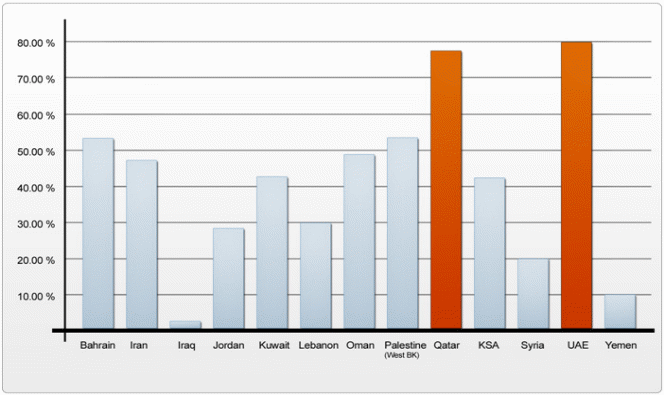
The graph above shows that most countries in the MENA region such as the UAE, Qatar, Palestine, Bahrain, and Palestine have the highest rate of Internet penetration. Countries in the MENA region, in collaboration with the Organization for Economic Cooperation and Development [OECD] countries, have undertaken several reforms over the past decades to improve the performance and governance of public institutions. Governments in the MENA region hold that the use of ICT and specifically the Internet constitutes the most fundamental aspect of achieving better governance.
Similarly, practitioners and scholars consider e-government as the heart of the public sector and service administration. However, the successful exploitation of ICT in the governance process is determined by the extent to which governments undertake public sector reforms, innovation, and modernization. The benefits of adopting ICT in the public sector are well illustrated by the commitment of the New Zealand government to ensure that ICT is implemented successfully. New Zealand expects to increase the level of engagement with its citizens considerably by 2020. This goal will be achieved by investing in network technologies (Lips, 2012).
To improve the contribution of the IT sector in improving the effectiveness of the public sector and public services, it is imperative for several changes to be undertaken. Governments in the MENA region must take into account the core drivers of e-government. First, the IT systems must be citizen-driven, which means that they must be characterized by a high degree of transparency, participation, and shared governance. Additionally, the IT systems must contribute to the creation of value, lead to a reduction in costs, and be developed effectively by synchronizing to different Internet-enabled tools and platforms. The chart below illustrates the key drivers in establishing a collaborative e-government system.
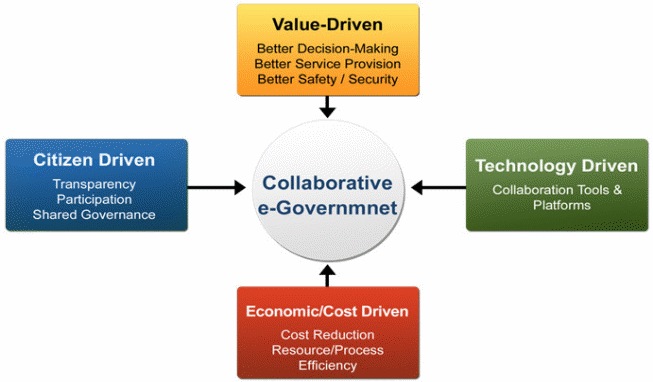
Shehadi and Khoury (2009) are of the opinion that the “region’s citizens must be technologically literate, have access to computers and the Internet” (p. 1). IT has provided governments in the MENA region an opportunity to offer customer-centric public services. In the course of implementing e-government, governments should understand the relationships that exist between the public sector and the external relationships. Through the implementation of IT, governments have been in a position to engage with the citizens by sharing information on different national issues. Thus, one can argue that IT has remarkably contributed to a high level of public participation in policy formulation processes.
One of the most notable impacts relates to the delivery of social services such as pension and wages. The Kingdom of Saudi Arabia and the UAE are committed to improving the living standards of their citizens through the implementation of effective systems of payment in their social security programs. The systems mainly target the poor and physically challenged. To achieve this goal, the MENA governments collaborate with non-government organizations and governments to ensure the transfer of pension to beneficiaries through banks and the mobile phone. The adoption of ICT has played a remarkable role in improving the transfer of payment to the target parties by lowering the cost of administration. Previously, the transfer of transfer payment to the poor amongst the MENA countries was characterized by a high level of inefficiency due to the high administrative cost as a percentage of the total spending as illustrated by the graph below.
![]()
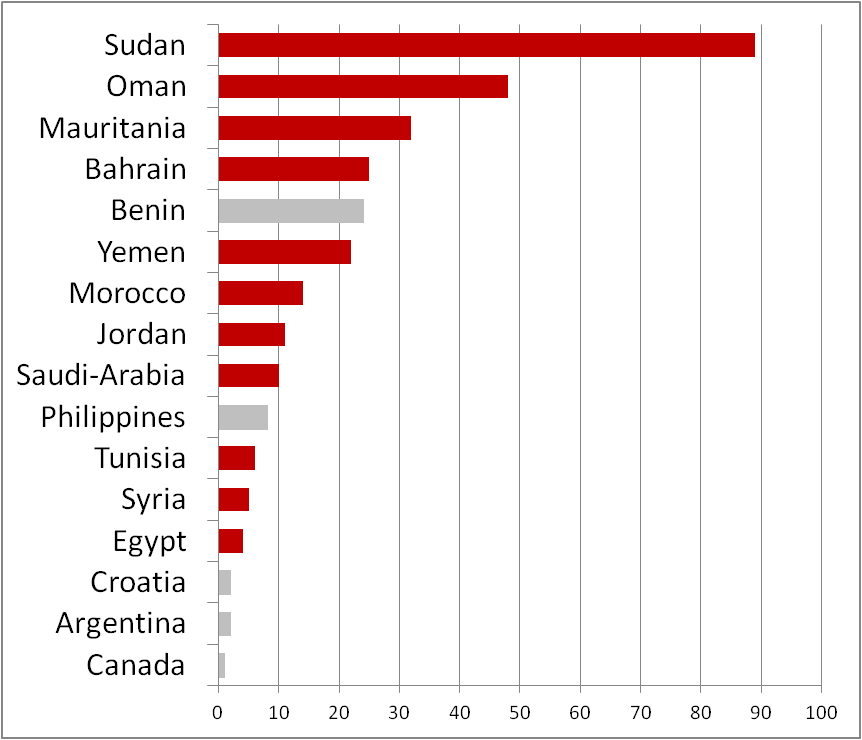
The graph above shows that the administrative cost of social services as a percentage of total spending is relatively higher in Mauritania, Oman, and Sudan as compared to Saudi Arabia, Tunisia, and Egypt. From the graph above, it is evident that information technology has significantly contributed to the reduction of administrative costs in delivering social services. IT reduces the administrative cost by ensuring that the beneficiaries’ personal information is recorded effectively. Some of the personal details entail photo and biometric data such as fingerprint amongst others.
IT has further improved the delivery of other public services such as education and health. This goal has been achieved through the integration of effective IT systems. MENA countries intend to improve the learning and teaching processes. Different public learning institutions are implementing e-learning systems such as video-sharing systems to deal with human capital challenges such as the shortage of teachers. The e-learning systems have allowed the MENA countries to improve learning in remote rural areas. This goal has been achieved through the implementation of the concept of distance learning. The e-learning process is enabled through the development of an effective database and online libraries, which ensure that learning is distributed equally to schools across the countries. Through e-learning, the MENA countries have been in a position to better the literacy levels, hence improving the likelihood of promoting economic growth. Furthermore, the implementation of IT has enabled the MENA countries to transform their economy into knowledge-based economies.
Challenges in public sector embracing information technology
The adoption of IT in the public sector and public services underscores the growth in recognition of the contribution of IT to economic growth and service delivery. However, public service delivery systems have not integrated the IT aspect fully. This limitation has arisen from several factors. One of the most notable challenges relates to the perceived usefulness. The usage of the implemented IT in delivering services in the public sector and public service can be explained by the Technology Acceptance Model, which is founded on two main assumptions, viz. the perceived usefulness and ease of use. The two aspects have a direct impact on the citizens’ behavioral intentions regarding ICT as illustrated in the figure below.
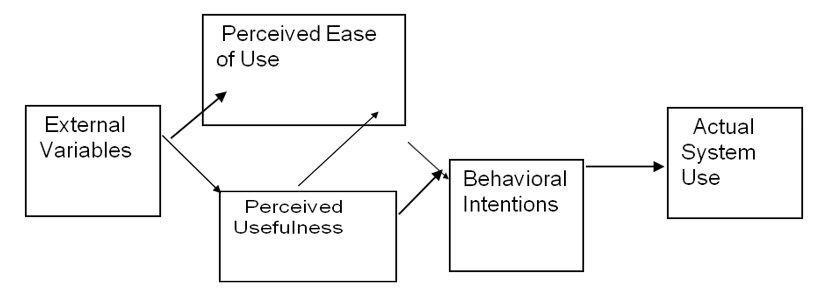
Citizens are likely to adopt IT in seeking services from the public sector if they believe that the technology will lead to a high level of effectiveness and efficiency. Thus, if citizens associate technology with high efficiency, the probability of embracing such technology is relatively high. Sinrod and Reilly (2000) collaborate that the citizens’ willingness “to transact public services using a particular IT system constitutes the perceived usefulness” (p. 177).
In most cases, citizens compare the efficiency of using the implemented IT systems with the existing traditional systems. Thus, one can argue that if the citizens believe that they will benefit from using the IT systems, the likelihood of embracing such technologies is high. Past studies show that the perceived usefulness of a particular technology is correlated positively with the consumers’ behavioral intentions. Other factors that influence the perceived usefulness are the contribution of the technology to promoting a high level of productivity, thus making the tasks being undertaken easier.
The extent to which citizens embrace the technology is subject to the level of satisfaction attained by using the service. Brown, Venkatesh, Kuruzovich, and Massey (2007) are of the view that expectations “serve as the anchor such that there is an ideal point of experience in which the difference between the expectations and the experience is minimized” (p. 54). In some instances, the citizens’ expectations of the implemented information technology systems may exceed their performance.
A study conducted in New Zealand on the utilization of ICT highlights the existence of significant gaps in the level of satisfaction between the private and public sectors. The study involving 26 research participants revealed that public sectors do not have a standardized approach on how to treat citizens despite the implementation of e-government applications. Citizens are concerned with why the level of satisfaction on ICT in the public sector cannot be equated to that of the private sector. Furthermore, citizens attain a high level of satisfaction by interacting with human beings as opposed to seeking different government services such as health, education, and other online services. This aspect illustrates the existence of significant gaps in the level of trust in e-government platforms.
In such situations, clients may develop a negative attitude towards information technologies such as under-fulfillment. Subsequently, the likelihood of such customers continuing using technology is reduced significantly. In the course of implementing IT in the public sector and public services, it is imperative for governments and other relevant stakeholders to examine the end-users’ expectations. Through this approach, it will be possible for governments to strike a balance between under-fulfillment and over-fulfillment amongst the users’ expectations. The outcome of establishing such a balance is that the government will establish an ideal point in the consumption of IT systems.
The continued usage of the implemented IT is further influenced by the citizens’ level of trust in the implemented systems. Fadel (2012) argues that trust forms the foundation of continued IT usage amongst the public. The level of trust influences the citizens’ post-usage attitude. Governments should take into account several issues in implementing IT. These aspects include competence, a high level of integrity, and benevolence.
Citizens are extensively concerned with the privacy and security of personal information transmitted over different IT systems. The majority of citizens are more confident about discussing personal and confidential aspects with human beings as compared to sharing such information online. Citizens adopt a multi-channel approach in seeking services from the public sector.
According to Lips (2012), “Individuals first search for information on government services online, and then they go into a government agency to get the right service and from a staff member they trust” (p. 276). Considering these aspects, it is essential for governments to ensure that they improve the consumption of e-government services. To improve the utilization of e-government platforms, the MENA countries should consider investing in the extensive development of the e-government platform. Thus, governments should not copy the online platforms used by private organizations. On the contrary, governments should explore how to develop a citizen-centric model.
Other factors limiting the utilization of IT entails the lack of awareness about the availability of the implemented IT platforms. Additionally, a considerable size of the population in the MENA region does not know how to use the implemented e-government systems. Basamh, Qudaih, and Ibrahim (2014) cite the lack of awareness and knowledge coupled with security threats as some of the major challenges affecting the implementation of IT in the public sector and public service in the MENA countries as illustrated by the graph below.
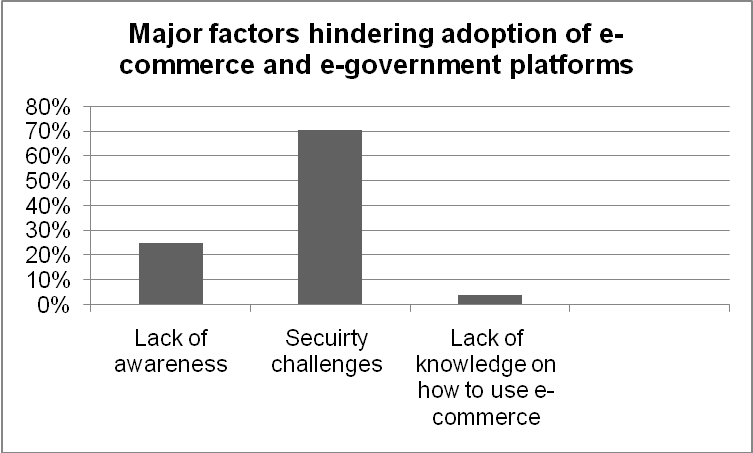
The graph identifies the lack of awareness and security challenges as the dominant challenges in the adoption of IT amongst the MENA countries. Despite the increased adoption of IT by governments, the industry continues to face a major challenge due to the existence of security threats. One of the most notable threats relates to the existence of a high rate of cyber-crime, as evidenced by phishing and hacking of computer systems. A report published by KPMG shows that cybercrime is gradually becoming sophisticated. Cybercriminals are adopting complicated technologies to access information being transmitted through different web-based technologies. Furthermore, the Oxford Business Group (2007) affirms that cybercriminals are targeting government systems.
The available literature shows that cybercrime has increased remarkably in the MENA countries over the past few decades. A report published by the Norton Cybercrime Report in 2011 affirms that over seventy-six percent of all Internet users in the UAE experienced cybercrime. Over, 1,400 incidences of cyber threats were recorded in 2013 in the UAE (Moukhallati, 2014). One of the factors that have led to the growth in the rate of cybercrime entails the high rate at which citizens are consuming online services such as social networks. The growth in the rate of cybercrime might affect the development of continued usage intention amongst citizens. Subsequently, the IT platforms implemented by the MENA governments in the administration of the public sector and public services will not contribute to the generation of the desired value.
Evolving strategies in on smart government and innovation in the UAE
The UAE is one of the MENA countries that have depicted commitment to implementing IT in the public sector and public service delivery processes. The UAE government is focused on promoting the usage of the Internet across the country. However, to achieve this goal, it is imperative for the UAE government to improve the ICT infrastructure. Gupta and Gupta (2012) affirm that the “UAE has been characterized by a remarkable increment in the rate at which government services are available online and the participation of public online activities” (p. 3).
To promote the utilization of the IT systems in the administration of the public sector and public service organizations, the UAE government has adopted a unique strategy aimed at improving e-readiness. The strategy focuses on three main strategic objectives, which include e-readiness, e-service, and improved ICT environment. The concept of e-readiness is concerned with strengthening the public sector and public service entities’ preparation in implementing ICT in their different operational processes such as organizational structures and HR competencies.
Conversely, the ICT environment is concerned with developing an enabling environment for the consumption of public services offered through the different IT platforms. Some of the aspects involved in establishing the ICT infrastructure entail effective legislation and policies on IT. The e-service dimension aims at promoting the rate of e-transformation amongst the public sector and public service entities. Additionally, the e-service dimension aims at ensuring that the public accesses high-quality electronic service through the implementation of effective and innovative delivery channels such as mobile phones and Internet kiosks amongst other Internet-enabled platforms.
Fernandes (2013) contends that e-readiness “is one of the core determinants in exploiting the benefits associated with e-commerce and e-government” (p. 145). First, the government has established regional hubs, viz. the Dubai Internet City and Dubai Media City. This move seeks to improve the citizens’ appreciation of web content consumption. Subsequently, the government has improved accessibility to information technology systems. Furthermore, the government is collaborating with content and software developers such as Microsoft to develop software in the Arabic language. This approach will increase the number of Emiratis who can use the implemented IT systems.
The UAE government has further focused on several areas as illustrated in figure 6 below.
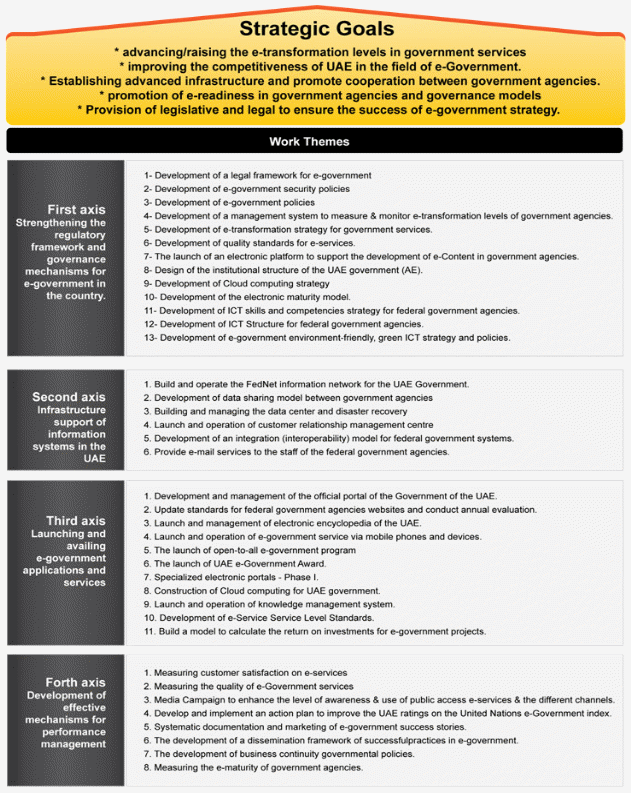
Another strategy that the UAE government is adopting entails the improvement of the ICT industry. One of the areas that the UAE government is focusing on relates to security. The UAE government is of the opinion that strengthening the regulatory framework will contribute considerably to the increased usage of ICT services. In 2007, the UAE government introduced Internet-specific laws aimed at protecting and regulating online activities. For example, the government enacted the Federal Cyber Law, which restricts and criminalizes cybercrime. By improving the regulatory framework, the UAE government expects to sustain a high level of data accuracy and privacy. Through this approach, the UAE government will be in a position to promote the level of confidence amongst its citizens. Thus, the country will experience continued usage of e-government systems.
The UAE government is also improving the country’s ICT infrastructure to increase the accessibility of public sector and public services via IT platforms to a large number of the Emiratis. One of the aspects that the UAE government is focusing on to promote the value of the implemented IT systems in the delivery of the public sector and public services is interoperability. The UAE government is launching a system, which will allow different government agencies to share information effectively and efficiently. This approach will provide citizens with an opportunity to access government services seamlessly. The improvement of infrastructure will also involve the establishment of a comprehensive data center to foster information and data sharing across different public sectors and public service entities.
The UAE government is in the process of establishing e-government applications and services. The government intends to achieve this goal by establishing a specialized electronic portal that can be accessed through different devices such as mobile phones. The applications will play an essential role in promoting the usage of IT services. The UAE government has also outlined its commitment to undertake periodic evaluation of the performance of the implemented IT systems in improving value creation in the public sector and public services. This strategy will be achieved by examining the level of satisfaction amongst citizens on e-services. The UAE government has shown its commitment to improving the country’s rating regarding the e-governance index. In addition to the above strategies, the UAE government will evaluate the e-maturity of different government agencies. Consequently, it will be possible to examine whether the public sector and public service entities are ready for a constant overhaul to align with the changing technological environment.
Conclusion
The implementation of IT systems has become a fundamental aspect of the governments’ delivery of services through the public sector and public service entities. Countries in the MENA region have appreciated the importance of IT systems in their governance systems. Subsequently, the adoption of the IT systems has improved service delivery to citizens across different public sectors. For example, the IT systems have led to remarkable improvements in the effectiveness and efficiency with which education and health services are delivered. This goal has been achieved through the implementation of e-learning. Conversely, the IT systems have improved the countries’ healthcare systems through the provision of certain online health services. Furthermore, IT systems have led to remarkable improvements in the administration of public finance. One of the notable ways through which this goal has been achieved is the implementation of IT services in the delivery of social security transfers to the poor.
Despite the progress made, the adoption of IT in the public service and the public sector continues to face a challenge. Some of the major challenges related to the lack of trust and knowledge, which is limiting the acceptance and continued usage of IT systems. To promote the implementation of IT systems in the public sector and public service, the UAE government has implemented several strategies. The strategies mainly focus on promoting the development of ICT infrastructure within the country and improving the level of confidence amongst the citizens. Through these approaches, the UAE government will improve the rate of usage on the implemented ICT platforms.
References
Alalwan, J. (2013). Continuance intention to use government 2.0 services; the impact of citizens’ satisfaction ad involvement. International Journal of Electronic Government Research, 9(3), 58-73.
Alkhouri, A. (2012). E-government strategies; the case of the United Arab Emirates [UAE]. European Journal of e-Practice, 3(17), 126-150.
Alzahrani, A., Stahl, C., & Prior, M. (2012). Developing an Instrument for e-public services’ acceptance using confirmatory factor analysis: Middle East context. Journal of Organizational and End User Computing, 24(3), 18-44.
Basamh, S., Qudaih, A., & Ibrahim, J. (2014). An overview on cyber security awareness in Muslim countries. International Journal of Information, 4(1), 21-24.
Brown, S., Venkatesh, V., Kuruzovich, J., & Massey, A. (2008). Expectation confirmation; an examination of three competing models. Organizational Behavior and Human Decision Processes, 105(4), 52-66.
Fadel, K. (2012). User adaptation and infusion of information systems. Journal of Computer Information Systems, 52(3), 1-10.
Fernandes, L. (2013). Security and trust in electronic business transactions-A study in the Middle East. ZENITH International Journal of Multidisciplinary Research, 3(2), 142-148.
Gupta, K., & Gupta, M. (2012). E-Governance Initiative in Cyber Law Making. International Archive of Applied Sciences & Technology, 3(2), 97-101.
Lips, M. (2012). E-government is dead: long live public administration. Information Polity, 17 (3), 29-250.
Moukhallati, D. (2014). Cyber crime in Dubai nearly doubled. Web.
Oxford Business Group. (2007). The report; Dubai 2007. London, UK: Oxford Business Group.
Saeed, K., & Abdinnour-Helm, S. (2008). Examining the effects of information system
characteristics and perceived usefulness on post adoption usage of information systems’, Information and Management, 45(3), 376-386.
Shehadi, R., & Khoury, P. (2009). Customer centric e-government; modernizing the MENA region’s public sector. Web.
Sinrod, E., & Reilly, P. (2000). Cyber-crimes: A practical approach to the application of federal computer crime laws. Santa Clara Computer & High Technology Law Journal, 16(2), 177-232.
